《大学英语翻译》课程PPT教学课件(口译)Module 5 Note-taking(1/2)
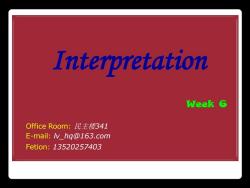
Interpretation Week G Office Room:民主楼341 E-mail:Iv_hq@163.com Fetion:13520257403
Interpretation Week 6 Office Room: 民主楼341 E-mail: lv_hq@163.com Fetion: 13520257403
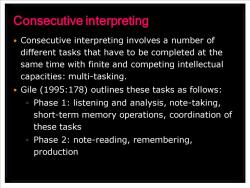
Consecutive interpreting Consecutive interpreting involves a number of different tasks that have to be completed at the same time with finite and competing intellectual capacities:multi-tasking. Gile (1995:178)outlines these tasks as follows: Phase 1:listening and analysis,note-taking, short-term memory operations,coordination of these tasks Phase 2:note-reading,remembering, production
Consecutive interpreting involves a number of different tasks that have to be completed at the same time with finite and competing intellectual capacities: multi-tasking. Gile (1995:178) outlines these tasks as follows: ◦ Phase 1: listening and analysis, note-taking, short-term memory operations, coordination of these tasks ◦ Phase 2: note-reading, remembering, production Consecutive interpreting
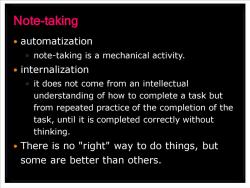
Note-taking 。automatization note-taking is a mechanical activity. 。internalization it does not come from an intellectual understanding of how to complete a task but from repeated practice of the completion of the task,until it is completed correctly without thinking. There is no "right"way to do things,but some are better than others
automatization ◦ note-taking is a mechanical activity. internalization ◦ it does not come from an intellectual understanding of how to complete a task but from repeated practice of the completion of the task, until it is completed correctly without thinking. There is no "right" way to do things, but some are better than others. Note-taking
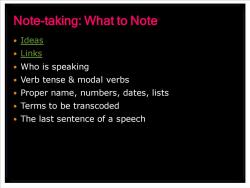
Note-taking:What to Note ·Ideas 。Links ·Who is speaking Verb tense modal verbs Proper name,numbers,dates,lists Terms to be transcoded The last sentence of a speech
Ideas Links Who is speaking Verb tense & modal verbs Proper name, numbers, dates, lists Terms to be transcoded The last sentence of a speech Note-taking: What to Note
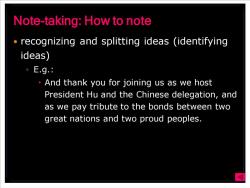
Note-taking:How to note recognizing and splitting ideas (identifying ideas) 。E.g And thank you for joining us as we host President Hu and the Chinese delegation,and as we pay tribute to the bonds between two great nations and two proud peoples
recognizing and splitting ideas (identifying ideas) ◦ E.g.: And thank you for joining us as we host President Hu and the Chinese delegation, and as we pay tribute to the bonds between two great nations and two proud peoples. Note-taking: How to note
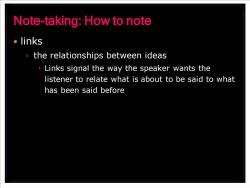
Note-taking:How to note 。links the relationships between ideas Links signal the way the speaker wants the listener to relate what is about to be said to what has been said before
links ◦ the relationships between ideas Links signal the way the speaker wants the listener to relate what is about to be said to what has been said before Note-taking: How to note

Note-taking:How to note links 。E.g. There are too many distinguished guests to mention all of you tonight.But I do want to acknowledge a few who have championed relations between our nations:First of all, President Jimmy Carter and his wonderful wife Rosalynn Carter are here.(Applause.As well as President Bill Clinton and my outstanding Secretary of State,Hillary Clinton.(Applause
links ◦ E.g. ◦ There are too many distinguished guests to mention all of you tonight. But I do want to acknowledge a few who have championed relations between our nations: First of all, President Jimmy Carter and his wonderful wife Rosalynn Carter are here. (Applause.) As well as President Bill Clinton and my outstanding Secretary of State, Hillary Clinton. (Applause.) Note-taking: How to note
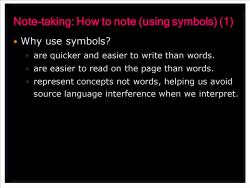
Note-taking:How to note (using symbols)(1) ·Why use symbols? are quicker and easier to write than words. are easier to read on the page than words. represent concepts not words,helping us avoid source language interference when we interpret
Why use symbols? ◦ are quicker and easier to write than words. ◦ are easier to read on the page than words. ◦ represent concepts not words, helping us avoid source language interference when we interpret. Note-taking: How to note (using symbols) (1)
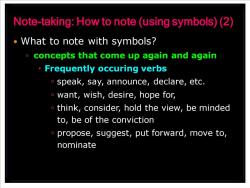
Note-taking:How to note (using symbols)(2) What to note with symbols? concepts that come up again and again Frequently occuring verbs speak,say,announce,declare,etc. want,wish,desire,hope for, think,consider,hold the view,be minded to,be of the conviction propose,suggest,put forward,move to, nominate
What to note with symbols? ◦ concepts that come up again and again Frequently occuring verbs ◦ speak, say, announce, declare, etc. ◦ want, wish, desire, hope for, ◦ think, consider, hold the view, be minded to, be of the conviction ◦ propose, suggest, put forward, move to, nominate Note-taking: How to note (using symbols) (2)
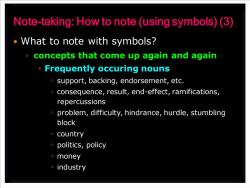
Note-taking:How to note(using symbols)(3) What to note with symbols? 。 concepts that come up again and again Frequently occuring nouns support,backing,endorsement,etc. consequence,result,end-effect,ramifications, repercussions problem,difficulty,hindrance,hurdle,stumbling block country 。politics,policy money industry
What to note with symbols? ◦ concepts that come up again and again Frequently occuring nouns ◦ support, backing, endorsement, etc. ◦ consequence, result, end-effect, ramifications, repercussions ◦ problem, difficulty, hindrance, hurdle, stumbling block ◦ country ◦ politics, policy ◦ money ◦ industry Note-taking: How to note (using symbols) (3)
按次数下载不扣除下载券;
注册用户24小时内重复下载只扣除一次;
顺序:VIP每日次数-->可用次数-->下载券;
- 《大学英语翻译》课程PPT教学课件(口译)Module 5 Consecutive interpreting.ppt
- 《大学英语翻译》课程PPT教学课件(口译)Module 5 Note-taking(2/2).ppt
- 《大学英语翻译》课程PPT教学课件(口译)Module 6 Simultaneous interpreting.ppt
- 《大学英语翻译》课程PPT教学课件(汉译英)第3讲 翻译中的句式衔接与布局.ppt
- 《大学英语翻译》课程PPT教学课件(汉译英)第1讲 汉译英概论.ppt
- 《大学英语翻译》课程PPT教学课件(汉译英)第2讲 翻译中的形合与意合.ppt
- 《大学英语翻译》课程PPT教学课件(汉译英)第4讲 词性转换.ppt
- 《大学英语翻译》课程PPT教学课件(汉译英)第6讲 长句的翻译.ppt
- 《大学英语翻译》课程PPT教学课件(汉译英)第7讲 公示语和翻译中的文化.ppt
- 《大学英语翻译》课程PPT教学课件(汉译英)第5讲 信息结构与翻译.ppt
- 《大学英语翻译》课程PPT教学课件(英译汉)Unit 2 Diction.ppt
- 《大学英语翻译》课程PPT教学课件(英译汉)Unit 4 Omission.ppt
- 《大学英语翻译》课程PPT教学课件(英译汉)Unit 3 Amplification.ppt
- 《大学英语翻译》课程PPT教学课件(英译汉)Unit 1 Translation Criteria.ppt
- 《大学英语翻译》课程PPT教学课件(英译汉)Unit 7 Passive Voice.ppt
- 《大学英语翻译》课程PPT教学课件(英译汉)Unit 8 Affirmative vs negative.ppt
- 《大学英语翻译》课程PPT教学课件(英译汉)Unit 5 Conversion.ppt
- 《大学英语翻译》课程PPT教学课件(英译汉)Unit 6 Restructuring.ppt
- 《大学英语翻译》课程PPT教学课件(英译汉)Unit 10 Attributive clauses.ppt
- 《大学英语翻译》课程PPT教学课件(英译汉)Unit 13 Long sentences.ppt
- 《大学英语翻译》课程PPT教学课件(口译)Module 3 memory, retelling & summarizing.ppt
- 《大学英语翻译》课程PPT教学课件(口译)Module 2-3 sight translation(C-E).ppt
- 《大学英语翻译》课程PPT教学课件(口译)Module 4 Escort & liaison interpreting.ppt
- 《大学英语翻译》课程PPT教学课件(口译)Module 3 memory & summarizing.ppt
- 《大学英语翻译》课程PPT教学课件(口译)Module 2-1 sight translation(specific skills).ppt
- 《大学英语翻译》课程PPT教学课件(口译)Module 2-2 sight translation(speed control).ppt
- 《大学英语翻译》课程PPT教学课件(口译)Module 1 Introduction to interpreting course & lead-in.ppt
- 《大学英语翻译》课程PPT教学课件(口译)Module 4 Escort & liaison interpreting(Exercise).ppt
- 《大学英语》课程教学大纲(College English).pdf
- 《大学英语教程》课程教材配套电子教案(PPT教学课件,北大版)第一册 第四单元.pptx
- 《大学英语教程》课程教材配套电子教案(PPT教学课件,北大版)第四册 第八单元.pptx
- 《大学英语教程》课程教材配套电子教案(PPT教学课件,北大版)第一册 第三单元.pptx
- 《大学英语教程》课程教材配套电子教案(PPT教学课件,北大版)第四册 第四单元.pptx
- 《大学英语教程》课程教材配套电子教案(PPT教学课件,北大版)第一册 第二单元.pptx
- 《大学英语教程》课程教材配套电子教案(PPT教学课件,北大版)第三册 第一单元.pptx
- 《大学英语教程》课程教材配套电子教案(PPT教学课件,北大版)第三册 第三单元.pptx
- 《大学英语教程》课程教材配套电子教案(PPT教学课件,北大版)第三册 第二单元.pptx
- 《大学英语教程》课程教材配套电子教案(PPT教学课件,北大版)第三册 第八单元.pptx
- 《大学英语教程》课程教材配套电子教案(PPT教学课件,北大版)第三册 第七单元.pptx
- 《大学英语教程》课程教材配套电子教案(PPT教学课件,北大版)第一册 第一单元.pptx
